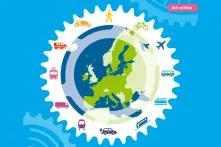
Inefficiencies in the transport system are caused by false prices. A high amount of costs is passed from the polluter to the general public. This ‘externalisation’ prevents fair competition in transport and must be changed.

Traffic causes high consequential costs that are passed on to the general public. These include damage caused by climate change, air pollution, traffic accidents and noise. These so-called external costs do not appear on either the fuel bill or the air ticket and they vary according to the means of transport. Passing on the external costs is contrary to the polluter-pays principle, whereby the damage is paid for by whoever caused it. In the EU-28 (including the United Kingdom), these costs can be calculated at almost 716 billion euros in 2016. Accidents account for the largest subsection, at 282 billion euros.
How are external costs calculated? Experts have agreed on certain rules for this. For the calculation of accident damage, the “Handbook of external costs in transport” of the European Commission provides so-called damage cost rates. For each EU Member State, the handbook contains amounts for fatalities as well as light and serious injuries, which are adjusted to the price level of the country. The damage cost rates take into account, among other things, medical care, the deployment of police and ambulances and absence from work, and they also ‘value’ the pain and suffering of the accident victims and their families.
The climate costs of transport in EU-28 in 2016 amounted to around 140 billion euros. The underlying losses, mainly due to global warming, are also converted into money on the basis of cost rates. The European Commission’s above-mentioned handbook uses avoidance costs. The cost rate determines the least-cost option to meet the 2-degree target of the Paris Agreement. The handbook recommends the cost rate of 100 euros per ton of CO2 equivalent.
From an economic point of view, the externalisation of costs prevents fair competition among modes of transport. Some pass on parts of their costs to the environment and people, others try to avoid this and make sustainable offers. For this reason, many economists believe that the state should intervene and ensure that the costs that have traditionally been externalised are internalised.
Most users of motorised transport in Europe already pay taxes and charges. Energy taxes are levied, taxes for purchasing or owning a vehicle are common and VAT is charged on all transport services except international aviation. Some countries have additional charges such as distance-based tolls, time-based vignettes or urban road pricing systems and parking fees. However, when comparing all revenues taxes and charges with all external costs and infrastructure costs for road passenger transport, only 45 percent of the costs are covered in EU-28. This cost factor significantly varies between Member States, from 17 percent in Luxemburg to 99 percent in Denmark due to e.g. different tax rates.
For climate protection in transport, the way in which the previously externalised climate costs are internalised is critical. The choice is between a direct CO2 tax or emissions trading with CO2 certificates, which would be technically and legally challenging. Moreover, it would take several years to be embedded in the transport sector – lost time for climate protection. Furthermore, the potentially low prices for certificates do not provide a strong incentive to switch to climate-friendly technologies. This would be expensive for the economy and for people, because the connection to global developments would be missed.
Because emissions trading is difficult to implement, many experts currently consider a CO2 tax to be the better option. The CO2 tax could be introduced at national level in the short term and added to existing energy tax rates. Petrol, diesel and other fossil fuels would quickly become noticeably more expensive. The CO2 tax would have to be set so high and increase so much over the years that the car industry would be under constant pressure to innovate and to enable consumers to plan their (car) investments and to choose their means of transport according to prices that are also ecologically true.
Because not everyone can afford to quickly get out of the significantly more expensive individual car traffic, many CO2 price concepts include social compensation components. For example, tax revenues could be handed back to the citizens through per capita payments or a compensation fund. However, there is also a discussion about whether the revenue from the CO2 tax should be channelled into the rail or cycling network and other infrastructure – necessary for a transition of the transport system. Overall, an effective CO2 tax is a central component of a climate-friendly mobility policy.
Since climate effects are only one of the external costs, further incentives to foster the change of behaviour are needed. Twenty-four countries of the EU-28 already apply distance-based road tolls or vignettes. Distance-based systems are most fair, since intense users are charged most and the pricing schemes can vary by road, amount of traffic, time or emission level to encourage efficient behaviour. Seven cities across the EU-28 already use urban road pricing to intelligently reduce car traffic and congestion, improve environmental qualities and increase quality of life.
The goal of increasing the costs of transport is not to punish people, to generate revenues or to impede mobility. The current transport system is inefficient due to false prices, resulting in a high congestion level and severe environmental effects. With true prices, more environmentally friendly modes of transport will become more attractive as an adequate alternative for many car trips.
Source for data and graphics: European Commission, State of play of internalisation in the European transport sector, https://bit.ly/2HCGSbm; European Commission, Handbook on the external costs of transport, https://bit.ly/2UWnFo7

